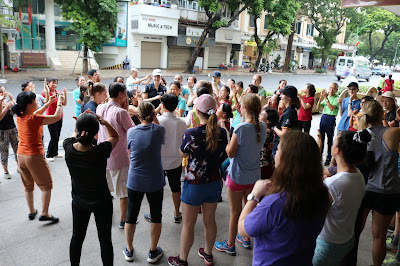Photograph walking back down from Camp Carroll, chosen by Maddison Lawrie as a special image from the trip to Vietnam.
Maddison writes:
The unexpected lessons
I am so grateful
to Malcolm for encouraging me to take the trek to Camp Carroll. This was an
experience, a series of special moments, that one snapshot that I nearly
missed. For me, this image encompasses so many different aspects of our time in
Vietnam, and is a reminder of the lessons I learnt, the memories I made and the
experiences that had an enriching impact on me.
Located south of the DMZ along Route 9
in Quang Tri province, Camp Carroll, the American Marine Artillery Base from 1966-72, was
nothing like I’d expected. Once a launch point for patrols and operations in and around the
DMZ area and home to thousands of marines, there is nothing left to suggest that
there was ever an American presence there. The only evidence remaining from the
war was a memorial for the North Vietnamese Army (NVA) which was situated at
the top of the track.
Although the walk
up was amazing it was the descend from the 3km track that was the most
spectacular sight I encountered during my time in Vietnam. The track provided
me with a peacefulness, calmness and sense of place that I have not experienced
before. The view included lush greenery made up of banana palms & other
Vietnamese natives that guided the boundary of the track. The mountains in the
distance that so subtly revealed themselves as you made your way around the
different curves & bends, watched over the locals who had built their homes
in amongst the track’s vegetation. To me, this symbolised ‘growth’ and ‘life’
and taught me that even after damage is done that nature and humanity have the
ability to grow, repair and progress.
My most favourite though, the local families who
we passed going about their daily activities or the ones who made their way to
the top of their driveways with their children to greet and interact with the
foreigners who were making their way up and down the track. All of the locals
we encountered were genuinely intrigued by & welcoming of these Australians
walking up their path. Although our languages created a barrier, our ability to
communicate through some broken Vietnamese and English, otherwise mainly nonverbal
interaction, made this walk an extraordinary experience for me. The creativeness in hand gestures, the facial
expressions and sharing of smiles was truly heart-warming. Also, the trust of
these mothers and fathers who so happily allowed their children to talk and
play with the Aussies on the track. How these people could be so openhearted to
complete strangers, especially given the experiences so many of them to would
have encountered being so close to the conflict zone, restored my faith in
humanity. This 3km walk was like nothing
I’ve ever experienced before and now; this image will be forever imprinted into
my mind along with the memories I have stored with it. Although no photo could
ever do it justice, the above is the closest I have to it.











































